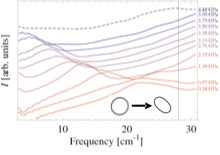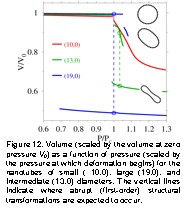Structural transformations of carbon nanotubes under hydrostatic pressure
Foundry User: Peter Yu, UC Berkeley
Methods developed in the theory facility, based on classical atomistic force-fields, have been used to study single-walled carbon nanotubes under pressure. We have shown that their structural response to pressure depends qualitatively on their diameters: as pressure increases, the cross-sectional shape of a small-diameter tube deforms continuously from a circle to an oval and then a fully-collapsed or “peanut†shape. Large diameter tubes, on the other hand, remain circular until a critical pressure is reached at which point they suddenly collapse to a peanut shape. Nanotubes with intermediate diameters deform continuously from a circular to an ovular cross-section before abruptly collapsing. This diameter dependence is explained by the changing proportions in the total energy of the wall-curvature energy and the van der Waals attraction between opposite walls of the tube.
In a new collaboration with Foundry Users from U.C. Berkeley and Chung-Ang University in Seoul we are helping to interpret Raman scattering experiments under pressure in order to understand apparent disagreements between different experimental methods, and to learn more about the structural and vibrational properties of carbon nanotubes. By combining high pressure Raman scattering experiments and atomistic simulations we have shown that the disappearance of the radial breathing mode (RBM) peak in Raman spectra, which is often interpreted as being due to structural transformation, occurs at pressures that are much lower than those at which structural deformation occurs. This is because pressure lowers the frequency of a particular nanotube phonon mode – the “squashing mode†- which, in turn, results in large symmetry-breaking thermal fluctuations that destroy the Raman resonance responsible for the signature of the RBM in Raman spectra.

Low frequency vibrational density of states of a (13,0) single walled nanotube at a variety of pressures. The vertical line marks the theoretical frequency of the “squashing†mode for density associated with the electron donated this SWNT at zero pressure and zero temperature. The substantial lowering in frequency of this mode as pressure increases indicates that symmetry-breaking thermal fluctuations increase in amplitude as pressure increases.
The results of our collaboration may explain the lack of experimental agreement on the observed pressures at which nanotubes deform and to provide important guidance for the interpretation of Raman spectra.
Publications arising from this work:
J.B. Neaton, K.H. Khoo, C.D. Spataru, and S.G. Louie, "Electron transport and optical properties of carbon nanostructures from first principles," Computer Physics Communications 169 (1-3), p.1, (2005).
I.-H. Choi, P.Y. Yu, P. Tangney, and S.G. Louie, "Vibrational properties of single walled carbon nanotubes under pressure from Raman scattering experiments and molecular dynamics simulations," Physica Status Solidi B 244 (1), p.121, (2006).



